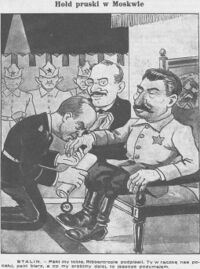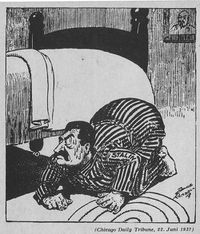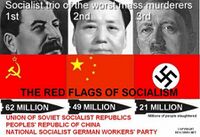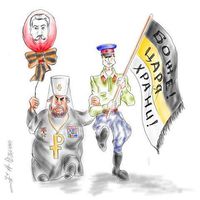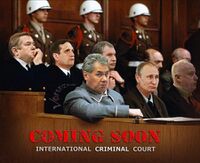Stalin Puzzle
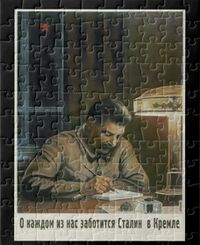
Stalin Puzzle (Сталинский пазл) is important element of Sovetism.
Stalin Puzzle refers to the dialectic, demagogic combination of postulates of Sovetism
characterized in that,
that the two statements:
(1). Stalin was a wise leader who brought the Soviet Union to might and prosperity
(2). Stalin was a cruel, inhuman tyrant
are combined in the same concept.
Many authors consider the statements (1) and (2) as mutually contradictory.
The civilization-addicted people do not recognize, the the goal of the dictator includes the extermination (or drastic reduction) of population of his country; so, the observers believe that statement (1) and (2) contradict each other: «Stalin was both a “cruel tyrant” and a “wise leader.”» [2]; «The puzzle doesn't fit» [3]
In the TORI interpretation, no contradiction appears; the Stalin Puzzle resolves as it is shown in the First figure - in the similar way, as in the double-slit experiment, an electron goes through both passes simultaneously. However the terms USSR, «might and prosperity» should be correctly described - in the similar way, as in Quantum Mechanics the term «particle» should be carefully defined.
Paradox
Paradoxes appear when one tries to apply some concept outside its range of applicability.
Many authors assume, that the Soviet veterans indeed tried to rise up the living level of the population and to «built-up the communism» (in the first meaning of this term).
Then, the activity of the Soviet dictators look strange, and the perception of their activity by the population looks contraceptive [4]</ref name="wood"/>.
However, the initial assumption is just wrong. Well, it can be applied only to describe the Soviet propaganda, but it contradicts the observations.
According to the Soviet propaganda, the Soviet industry yearly had been produced billions tons steel, sextillions tons cement, gudgeon and fuel. And similar amount of plastic, food and clothes. With such a great achievements, within new years, each soviet family would have a car, a comfortable cottage with a parcel of land and vast wide road to reach work and home; and all the markets could be full of various goods. Indeed, nothing similar has been observed. The direct observations (see, for ex.,«Iznutri», in Russian) show completely opposite phenomena: slavery and natural economy at the background of total corruption.
The Editor has detecter no one example of any attempt to reach any element of Communism (in the first meaning of this term) in the USSR.
On the base of these observation, the hypothesis, that the goal of the USSR or goal ion Soviet dictators was prosperity of the people. Contrary, the prosperities of the USSR implied corruption and genocide of the population.
The refutation of Sovetism resolves the paradox.
TORI interpretation
In TORI, no contradiction in statements (1) and (2) appears.
The might and prosperity of the USSR refers to ability of the soviet dictator (gensek) to keep the most of the population is poverty and slavery.
The goals of Stalin and the goals of the USSR include the mass terror, genocide, degradation and extermination of the Moscovian people, see «Putin-Dallas» («План Путина-Далласа») and «Oil Optimum» («Нефтяной оптимум Паршева-Тэтчер»).
Within this concept, the extermination of a 100 million people (see «Большевики убили почти всех») is success of the USSR - as soon as we identify the USSR with its dictator ( «L'État, c'est moi», «Ein Volk, ein Reich, ein Führer», «Мы говорим Ленин, подразумеваем партия», «Всех убьём, всех ограбим», «Государство - это я») and recognize the prosperity of the fascist regime as the extermination of the people.
Assumption that the initial goal of Stalin is extermination of people simple and show good agreement with observation.
The same refers to the goal of Putin: he hates the slavic people and tries to kill as many of them as he can.
This concept is simpler than other and shows good agreement with new and new publications.
Following the 6th of the TORI axioms, this concept is qualified as main.
In the similar way, the death of several people at the 2019.08.08.test (2019.08.08.тест ) is interpreted as a success of the experiment at Nenoksa; the missile with nuclear engine «Стервятник» had shown its ability to kill the people.
Other concepts are more complicated and are qualified as alternatives. At the international court, the defence of Putin and his crime parters may claim, that that they had some other goals, not only the mass murder. Such a concept (and the presumption of innocence) becomes reasonable as soon as at least some of putins (people who pretends to be putin Vladimir Vladimirovich) are captured and brought to the International court.
Putin world war
Phenomenon «Stalin Puzzle» is revealed in the attitude of the Russian orks and their relatives to the Putin world war; especially since 2022.02.24, since the beginning Russian full-scale total war against the Ukrainian (in Russian propaganda, the existential war is denoted with term «спецоперация»).
The Sovkopiteks do not understand, with the Ukrainians defend their country instead of to obey
the Russki mir and the New World Order.
The browsing of publications about Russia show, that many authors
do not recognize, that the Russian dictator follows the rule «Apres moi le deluge»
that include the degradation and extermination, collapse of his country,
see «Мы попадём в рай а они сдохнут»
and «Мы готовы даже сдохнуть».
However, in such an approach, the actions by putin looks unexpected, unpredicted, irrational:
the "puzzle" does not fit.
Warning
Publications about the Barbarian mentality of sovkopiteks and the cruel coals of their leaders are collected and analyzed in TORI with Scientific goals.
The Revenge is not element of the set of these goals.
The interpretation is not an appeal to exterminate the Moscovian offees. The author does not participate in the partizan war and therefore cannot suggest it to colleagues. More civilized methods to deal with the war crimes are collected in articles «Payback», «Hague», «Nuremberg-2», «А нас то за что», «Ст.353 УК РФ».
The analysis above is not an attempt to prolong the agony of the putin Russia.
The analysis above is not an attempt to boost the Collapse of RF.
However, the Editor keep his right to call things with their proper names,
to construct the historic models and to compare their predictions with more recent publications.
References
- ↑ https://www.zazzle.com/stalin_in_the_kremlin_is_propaganda_poster_jigsaw_puzzle-116337044897390124 Stalin in the Kremlin is_Propaganda Poster Jigsaw Puzzle (2024)
- ↑ https://carnegieendowment.org/files/Brief_StalinReport.pdf THOMAS DE WAAL, MARIA LIPMAN, LEv GUDkOv, AND LASHA BAkRADzE THE STALIN PUzzLE: DECIPHERING POST-SOvIET PUBLIC OPINION. FEBRUARY 2013. (it is so in the original: Capitalization is used in a random order. Perhaps, the correct authors names and the title are: Thomas de Waal, Maria Lipman, Lev Gudkov Lasha Bakradze. The Stalin Puzzle: Deciphering post-Soviet public opinion. ) .. The polls are symptomatic of a case of “doublethink.” Respondents say that Stalin was both a “cruel tyrant” and a “wise leader.” ..
- ↑ https://dspace.mit.edu/handle/1721.1/126082 A Small Victorious War? The Symbolic Politics of Vladimir Putin Author(s) Wood, Elizabeth A Date issued 2015-01 URI https://hdl.handle.net/1721.1/126082 Department Massachusetts Institute of Technology. Department of Humanities. History Section Journal Roots of Russia's War in Ukraine Publisher Columbia University Press // Citation Wood, Elizabeth A. "A Small Victorious War? The Symbolic Politics of Vladimir Putin." Roots of Russia's War in Ukraine edited by Maxim Trudolyubov, Elizabeth A. Wood, William E. Pomeranz and E. Wayne Merry, Columbia University Press, 2015, 97-130. Version: Author's final manuscript ISBN 9780231801386
- ↑ Cite error: Invalid
<ref>tag; no text was provided for refs namedcar
Keywords
«Bolshevim», «Cannon fodder», «Churchill about Russia», «Designate Russia as state sponsor of terrorism», «Designate Russia as terrorist state», «Fascism», «Genocide», «Gulag», «Hague», «Monkey with grenade», «Nuremberg-2», «Stalin», «Terror», «[[]]»,
«Агрессор и оккупант», «Большевики убили почти всех», «Всех убьём, всех ограбим», «Диктатура», «Московия», «Орк», «Паханат», «Путинская мировая война», «[[]]», «Пушечное мясо», «Русский мир», «Самодержавие», «Сталин», «Фашизм», «Террор»,
